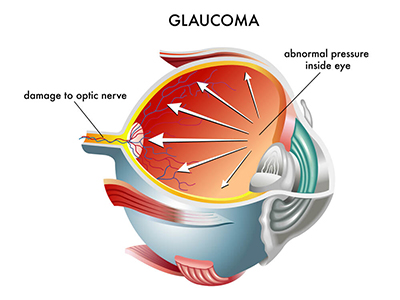Glaucoma
Protect your vision with early detection and expert care.
Berg Feinfield Vision Correction offers comprehensive glaucoma care in the Los Angeles area, with services available at their Burbank location, where Dr. Lilit Minasyan leads glaucoma evaluations and treatments.
 Locations: Burbank
Locations: Burbank
Doctor: Dr. Lilit Minasyan
What is Glaucoma?
Glaucoma is a group of eye conditions that damage the optic nerve—the part of your eye that sends visual information to your brain. Think of it like a cable connecting your eye to your brain: when that cable is damaged, your vision can slowly fade, often without early warning signs.
Glaucoma is often caused by increased pressure inside the eye (intraocular pressure), but it can also occur with normal pressure. Without treatment, it can lead to permanent vision loss.
Types of Glaucoma and Symptoms
Glaucoma is divided into two broad categories based on the anatomy of the angle where the trabecular meshwork is found. They are open-angle and closed-angle.
Open-Angle Glaucoma (most common)
The most common type. It happens slowly as the eye’s drainage system becomes less efficient, causing pressure to build up over time. Often called the “silent thief of sight” because it usually has no early warning signs. But over time, patients may notice:
-
Gradual loss of peripheral (side) vision
-
Difficulty seeing in low light
-
Blind spots in your vision (especially in the sides or corners)
-
Tunnel vision in advanced stages
Angle-Closure Glaucoma (medical emergency)
Less common but more serious. Pressure rises quickly when the eye’s drainage angle gets suddenly blocked—this is a medical emergency. This type can come on suddenly and may include:
-
Eye pain
-
Severe headache
-
Blurred vision
-
Halos around lights
-
Nausea or vomiting
-
Redness in the eye
How We Detect Glaucoma?
At Berg Feinfield, we use advanced tools to detect glaucoma as early as possible:
-
Eye Pressure Check (Tonometry): Measures the pressure inside your eye.
-
Corneal Thickness (Pachymetry): Helps us understand how thick your cornea is, which affects pressure readings.
-
Dilated Eye Exam: Allows us to see your optic nerve and check for signs of damage.
-
Visual Field Test: Looks for peripheral (side) vision loss, often an early sign of glaucoma.
-
Optic Nerve Imaging (OCT): Uses high-resolution scans to examine the nerve fibers and spot early damage.
Glaucoma Treatment Options
While glaucoma cannot be cured, its progression can be managed through various treatments:
-
Medications: Prescription eye drops to lower eye pressure.
-
Laser Therapy (Selective Laser Trabeculoplasty): Improves fluid drainage in the eye.
-
Surgical Procedures: For advanced cases, options like trabeculectomy or the implantation of glaucoma drainage devices may be necessary.
Why Choose Berg Feinfield?
Dr. Lilit Minasyan leads our glaucoma care team at our Burbank location, providing expert evaluation and treatment.Our focus is on early detection, advanced technology, and personalized care to preserve your vision.
To learn more about glaucoma, click on the links below.







